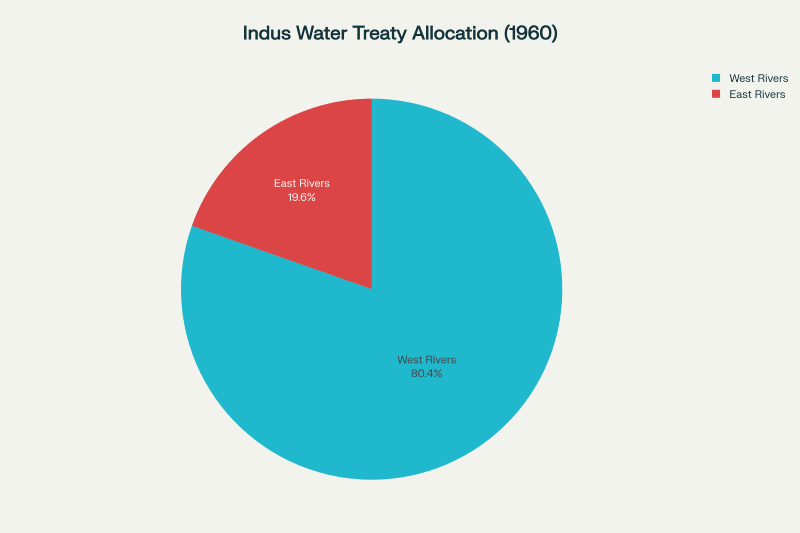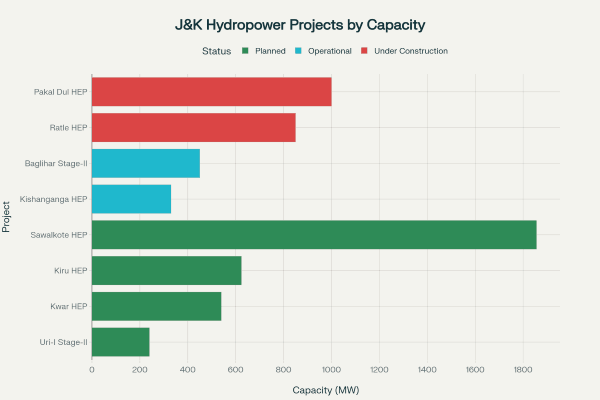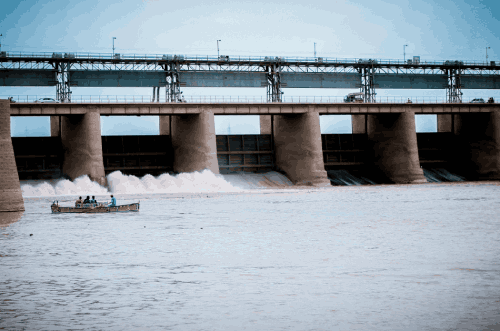The Indus Water Treaty of 1960, once celebrated as a rare example of successful water diplomacy between India and Pakistan, now stands suspended following India’s unprecedented decision in April 2025. This comprehensive analysis examines the structural inequities of the treaty, India’s strategic rationale for suspension, and the substantial long-term benefits that abeyance will deliver for India’s economic development, energy security, and geopolitical positioning.

Indus Water Treaty allocation showing Pakistan receives 80.4% of water flow while India gets only 19.6% despite being upstream
Historical Context and Treaty Provisions
The Indus Waters Treaty was signed on September 19, 1960, following nine years of negotiations mediated by the World Bank. The agreement emerged from the urgent need to resolve water disputes arising from the 1947 partition, when India began controlling the headwaters of rivers that Pakistan depended upon for irrigation.
The treaty’s core provisions divide the six-river Indus system into two categories. The Eastern Rivers (Ravi, Beas, and Sutlej) with an annual flow of 33 million acre-feet (MAF) were allocated exclusively to India. The Western Rivers (Indus, Jhelum, and Chenab) carrying 135 MAF annually were assigned primarily to Pakistan, though India retained limited usage rights for domestic consumption, irrigation, and run-of-river hydropower generation.
This allocation appears fundamentally asymmetric when analyzed objectively. Despite being the upstream riparian state with natural geographical advantages, India receives control of only 19.6% of the total water flow, while Pakistan controls 80.4%. This arrangement effectively constrains India’s development potential in its northern regions, particularly Jammu and Kashmir, which contributes significantly to the rivers but cannot fully utilize their waters.
The treaty includes detailed restrictions on India’s infrastructure development on the Western Rivers. India is limited to constructing run-of-river hydroelectric projects without substantial storage capacity. Any proposed project must be shared with Pakistan through the Permanent Indus Commission, giving Pakistan effective veto power over India’s development plans. Pakistan has consistently used this mechanism to delay and obstruct Indian projects, filing objections against virtually every major hydroelectric initiative.
India’s Path to Suspension
India’s decision to suspend the treaty did not emerge suddenly but followed years of systematic Pakistani obstruction and evolving strategic calculations. Since 2015, Pakistan has raised disputes over multiple Indian projects including the 330 MW Kishanganga and 850 MW Ratle hydroelectric plants. Rather than using the treaty’s prescribed dispute resolution mechanisms in good faith, Pakistan simultaneously approached both Neutral Expert procedures and the Court of Arbitration, violating the treaty’s sequential approach.
India formally notified Pakistan in January 2023 of its desire to modify the treaty, citing changed circumstances and Pakistan’s failure to cooperate constructively. A second modification notice followed in August 2024, emphasizing the treaty’s one-sided nature and Pakistan’s continued obstruction. These notices, conforming to international law requirements under the Vienna Convention on the Law of Treaties, provided Pakistan with opportunities to engage in meaningful negotiations.
The immediate trigger for suspension came with the Pahalgam terrorist attack on April 22, 2025, which killed 26 tourists in Indian-administered Kashmir. India attributed the attack to Pakistan-based militant groups, viewing it as part of Pakistan’s broader strategy of using terrorism to maintain pressure on India while simultaneously constraining India’s development through treaty mechanisms.
On April 23, 2025, India announced the treaty would be held in abeyance “until Pakistan credibly and irrevocably abjures its support for cross-border terrorism”. This marked the first time either country had suspended the agreement since its inception.
Strategic Benefits of Treaty Abeyance
Enhanced Hydropower Development
The most immediate and substantial benefit of treaty abeyance lies in unleashing India’s hydropower potential in Jammu and Kashmir. The region possesses an estimated hydropower potential of 20,000 MW, of which only 3,263 MW (16.3%) has been developed due to treaty constraints. Current operational capacity includes major projects like Baglihar (450 MW), Kishanganga (330 MW), Uri (480 MW), and Salal (690 MW).

Major hydropower projects in Jammu & Kashmir showing current and planned capacity additions post-treaty suspension
With treaty constraints removed, India can fast-track multiple projects previously stalled by Pakistani objections. The 1,856 MW Sawalkote project on the Chenab River, for which NHPC issued tenders in July 2025, represents the largest single hydroelectric initiative in the region. Additional major projects include the 1,000 MW Pakal Dul (currently 67% complete), 850 MW Ratle (under construction), 624 MW Kiru, and 540 MW Kwar projects.
These projects collectively represent over Rs 44,000 crore ($5.3 billion) in infrastructure investment and will add approximately 5,890 MW of clean energy capacity. Beyond immediate capacity additions, suspension enables India to redesign existing run-of-river projects to incorporate storage capabilities, fundamentally altering the region’s water management potential.
The hydropower expansion serves multiple strategic objectives. It contributes significantly to India’s target of 500 GW renewable energy capacity by 2030. It reduces dependence on fossil fuel imports, enhancing energy security. Most importantly, it provides India with enhanced control over water flows, creating strategic leverage in future negotiations with Pakistan.
Irrigation and Agricultural Development
Treaty abeyance opens vast opportunities for agricultural expansion in Jammu and Kashmir. Under the treaty, India is permitted to irrigate up to 13.4 lakh acres in the region. However, current irrigation covers only 6.42 lakh acres, representing less than 48% utilization of allowed potential.
The underutilization stems from treaty restrictions that prevented India from building necessary storage and distribution infrastructure. With these constraints removed, India can construct comprehensive irrigation networks to bring the remaining 6.98 lakh acres under cultivation. This expansion could generate annual economic benefits exceeding Rs 2,400 crore through increased agricultural production.
Four major irrigation projects are already being fast-tracked: the Tral Irrigation Project in Pulwama, Prakachik Khows Canal in Kargil, restoration of the main Ravi Canal in Jammu, and the Rajpora Lift Irrigation system. These projects will irrigate an additional 2.05 lakh acres at a cost of Rs 117 crore, demonstrating the economic viability of expanded irrigation infrastructure.
Enhanced irrigation capacity particularly benefits high-value crops like saffron, walnuts, and apples, which command premium prices in international markets. Improved water security will help stabilize production and potentially increase yields, providing economic opportunities for the region’s predominantly agricultural population.
Strategic Water Control and Leverage
Suspension transforms India from a constrained upstream state into one with full sovereign control over its water resources. This shift provides multiple strategic advantages in dealing with Pakistan’s continued support for cross-border terrorism.
India can now modify existing infrastructure operations without notifying Pakistan. The reservoir flushing operations conducted at Salal and Baglihar dams in May 2025 demonstrated this new flexibility. While these actions did not significantly impact water flows to Pakistan, they established important precedents for India’s enhanced operational freedom.
More substantially, India can now plan and construct storage infrastructure on the Western Rivers without treaty constraints. Proposed projects include four reservoirs on tributaries of the Chenab and Jhelum rivers. These facilities would provide India with genuine capacity to regulate water flows, creating substantial leverage in future diplomatic negotiations.
The psychological impact on Pakistan is already evident. Pakistani officials have warned that any attempts to stop water flows would be considered acts of war, while the army chief has threatened to destroy Indian dams with missiles. Such extreme reactions indicate Pakistan’s recognition that India now possesses meaningful leverage that didn’t exist under treaty constraints.
Economic and Infrastructure Development
Treaty abeyance catalyzes broader economic development in India’s northern regions. The hydropower and irrigation projects require massive infrastructure investments that generate employment, develop technical capabilities, and create economic multiplier effects.
The Jammu and Kashmir government has set targets to double power generation within three years through Rs 34,000 crore in power project investments. Five mega projects with combined capacity of 4,134 MW have been approved for execution, representing unprecedented infrastructure development in the region.
Beyond immediate project benefits, suspension enables India to develop more ambitious water management schemes. Plans under consideration include extending the Ranbir canal on the Chenab to 120 kilometers and potentially redirecting waters from the Indus system into rivers in other Indian states. Such projects, while requiring substantial time and investment, would fundamentally alter the region’s economic landscape.
The infrastructure development also enhances strategic connectivity and defense capabilities in the sensitive border region. Improved road networks, power transmission systems, and water management facilities strengthen India’s position in areas facing security challenges.
Climate Adaptation and Water Security
India’s northern regions face increasing climate vulnerabilities, including changing precipitation patterns, glacier retreat, and extreme weather events. Treaty constraints previously prevented India from building adaptive infrastructure to manage these challenges effectively.
With suspension, India can construct storage facilities that provide buffers against climate variability. Large reservoirs enable better management of seasonal water fluctuations and provide security against drought conditions. This capability becomes increasingly important as climate change intensifies water stress across South Asia.
The enhanced infrastructure also improves flood management capabilities. Better regulation of river flows through storage and diversion can reduce flood risks in downstream areas of both India and Pakistan. Paradoxically, this could benefit Pakistan while providing India with enhanced control.
Long-term Strategic Implications
Establishing New Negotiation Framework
Treaty suspension positions India to negotiate from strength in any future water-sharing arrangements with Pakistan. Rather than operating within the constraints of a 65-year-old agreement that allocated 80% of waters to Pakistan, India can now insist on more balanced arrangements that reflect contemporary realities.
The suspension effectively establishes that India will no longer accept asymmetric obligations that constrain its development while providing Pakistan with veto power over Indian projects. Any future negotiations must acknowledge India’s legitimate development needs and Pakistan’s inability to use terrorism as a diplomatic tool.
International law supports India’s position on treaty modification. The Vienna Convention on the Law of Treaties provides grounds for termination based on material breach or fundamental change of circumstances. Pakistan’s continued support for cross-border terrorism constitutes material breach, while climate change and population growth represent fundamental changes not anticipated in 1960.
Regional Power Dynamics
Suspension demonstrates India’s willingness to take decisive action despite international criticism and Pakistani threats. This resolve strengthens India’s negotiating position across multiple bilateral issues beyond water sharing.
The decision also signals to China and other upstream neighbors that India will not indefinitely accept disadvantageous arrangements that constrain its development. As India emerges as a major global power, its approach to the Indus treaty establishes precedents for asserting legitimate sovereign rights.
Pakistan’s extreme reactions, including nuclear threats and warnings of war, highlight its recognition that the balance of power has shifted decisively in India’s favor. These responses paradoxically strengthen India’s position by demonstrating Pakistan’s weakness and reliance on coercive threats.
Economic Transformation Potential
Full development of the Indus system’s potential could transform North India’s economic landscape. The region’s 20,000 MW hydropower potential, if fully realized, would position India as a major clean energy exporter. Enhanced irrigation could support agricultural intensification and diversification into high-value crops.
The infrastructure investments required – estimated at over Rs 75,000 crore ($9 billion) over 15 years – would create substantial employment and develop advanced engineering capabilities. This investment would also generate significant revenue through power sales and increased agricultural productivity.
Regional economic development could help integrate Jammu and Kashmir more fully into India’s national economy while providing legitimate alternatives to populations previously dependent on conflict economies.
Challenges and Risk Management
Infrastructure Development Timeline
Realizing the full benefits of treaty abeyance requires substantial time and investment. Major hydropower projects typically require 8-12 years for completion, while comprehensive irrigation systems need 5-8 years for development. India must maintain political will and financial resources across multiple electoral cycles to achieve these objectives.
The immediate benefits are therefore primarily strategic and political rather than economic. However, the precedent-setting value of suspension and the demonstration of India’s resolve provide important near-term advantages.
International Relations Management
Suspension has generated criticism from some international observers who viewed the treaty as a model of transboundary cooperation. India must manage these perceptions while pursuing its legitimate development interests.
However, international law supports India’s position, and the country’s growing global influence provides diplomatic resources to manage criticism. The Permanent Court of Arbitration’s ruling that India cannot unilaterally suspend proceedings does not negate India’s fundamental right to terminate or modify the treaty through proper legal channels.
Environmental Considerations
Large-scale water infrastructure development carries environmental risks that must be carefully managed. Dam construction in the sensitive Himalayan ecosystem requires environmental impact assessments and mitigation measures.
However, climate change and existing developmental pressures already stress regional ecosystems. Properly designed infrastructure can actually enhance environmental resilience by providing better water management and flood control capabilities.
Conclusion
India’s suspension of the Indus Water Treaty represents a calculated strategic decision that addresses decades of accumulated disadvantages under an asymmetric arrangement. The treaty’s fundamental inequity – allocating 80% of water to Pakistan while constraining India’s development despite its upstream position – was no longer sustainable given Pakistan’s continued support for terrorism and obstruction of legitimate Indian projects.
The long-term benefits of abeyance are substantial and multifaceted. Enhanced hydropower development will add nearly 6,000 MW of clean energy capacity while contributing to India’s renewable energy targets. Expanded irrigation will bring over 6 lakh acres of additional land under cultivation, generating thousands of crores in annual economic benefits. Most importantly, strategic water control provides India with meaningful leverage in future negotiations with Pakistan.
The suspension establishes important precedents for India’s approach to international agreements that constrain its development potential. As India emerges as a major global power, its willingness to assert legitimate sovereign rights while adhering to international law strengthens its negotiating position across multiple issues.
While realizing these benefits requires sustained political will and substantial financial investment over 10-15 years, the economic and strategic returns justify the effort. The estimated Rs 75,000 crore investment in hydropower and irrigation infrastructure will generate multiples of that amount in economic value while enhancing India’s energy security and regional influence.
Pakistan’s extreme reactions to the suspension, including nuclear threats and warnings of war, paradoxically validate India’s decision by demonstrating the effectiveness of water control as strategic leverage. These responses also highlight Pakistan’s fundamental weakness and dependence on coercive threats rather than constructive engagement.
The path forward requires careful implementation of major infrastructure projects, effective management of environmental concerns, and diplomatic efforts to maintain international support for India’s position. However, the suspension has already achieved its primary strategic objective of establishing that India will no longer accept asymmetric arrangements that benefit adversaries while constraining its own development potential.
In the long run, treaty abeyance positions India to negotiate more balanced water-sharing arrangements from a position of strength while fully realizing the economic potential of its northern regions. This transformation serves not only India’s immediate interests but also contributes to regional stability by demonstrating that terrorism cannot be used as an effective tool of statecraft against a confident and capable democracy.








